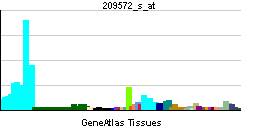EED
Jump to navigation
Jump to search
| Embryonic ectoderm development | |||||||||
|---|---|---|---|---|---|---|---|---|---|
| Identifiers | |||||||||
| Symbols | EED ; HEED; WAIT1 | ||||||||
| External IDs | Template:OMIM5 Template:MGI HomoloGene: 2814 | ||||||||
| |||||||||
| RNA expression pattern | |||||||||
 | |||||||||
 | |||||||||
| More reference expression data | |||||||||
| Orthologs | |||||||||
| Template:GNF Ortholog box | |||||||||
| Species | Human | Mouse | |||||||
| Entrez | n/a | n/a | |||||||
| Ensembl | n/a | n/a | |||||||
| UniProt | n/a | n/a | |||||||
| RefSeq (mRNA) | n/a | n/a | |||||||
| RefSeq (protein) | n/a | n/a | |||||||
| Location (UCSC) | n/a | n/a | |||||||
| PubMed search | n/a | n/a | |||||||
Embryonic ectoderm development, also known as EED, is a human gene.[1]
This gene encodes a member of the Polycomb-group (PcG) family. PcG family members form multimeric protein complexes, which are involved in maintaining the transcriptional repressive state of genes over successive cell generations. This protein interacts with enhancer of zeste 2, the cytoplasmic tail of integrin beta7, immunodeficiency virus type 1 (HIV-1) MA protein, and histone deacetylase proteins. This protein mediates repression of gene activity through histone deacetylation, and may act as a specific regulator of integrin function. Two transcript variants encoding distinct isoforms have been identified for this gene.[1]
References
Further reading
- Joseph AM, Kumar M, Mitra D (2005). "Nef: "necessary and enforcing factor" in HIV infection". Curr. HIV Res. 3 (1): 87–94. PMID 15638726.
- Van Maele B, Debyser Z (2005). "HIV-1 integration: an interplay between HIV-1 integrase, cellular and viral proteins". AIDS reviews. 7 (1): 26–43. PMID 15875659.
- Jones CA, Ng J, Peterson AJ; et al. (1998). "The Drosophila esc and E(z) proteins are direct partners in polycomb group-mediated repression". Mol. Cell. Biol. 18 (5): 2825–34. PMID 9566901.
- van Lohuizen M, Tijms M, Voncken JW; et al. (1998). "Interaction of mouse polycomb-group (Pc-G) proteins Enx1 and Enx2 with Eed: indication for separate Pc-G complexes". Mol. Cell. Biol. 18 (6): 3572–9. PMID 9584197.
- Sewalt RG, van der Vlag J, Gunster MJ; et al. (1998). "Characterization of interactions between the mammalian polycomb-group proteins Enx1/EZH2 and EED suggests the existence of different mammalian polycomb-group protein complexes". Mol. Cell. Biol. 18 (6): 3586–95. PMID 9584199.
- Denisenko O, Shnyreva M, Suzuki H, Bomsztyk K (1998). "Point mutations in the WD40 domain of Eed block its interaction with Ezh2". Mol. Cell. Biol. 18 (10): 5634–42. PMID 9742080.
- Rietzler M, Bittner M, Kolanus W; et al. (1998). "The human WD repeat protein WAIT-1 specifically interacts with the cytoplasmic tails of beta7-integrins". J. Biol. Chem. 273 (42): 27459–66. PMID 9765275.
- Schumacher A, Lichtarge O, Schwartz S, Magnuson T (1999). "The murine Polycomb-group gene eed and its human orthologue: functional implications of evolutionary conservation". Genomics. 54 (1): 79–88. doi:10.1006/geno.1998.5509. PMID 9806832.
- Peytavi R, Hong SS, Gay B; et al. (1999). "HEED, the product of the human homolog of the murine eed gene, binds to the matrix protein of HIV-1". J. Biol. Chem. 274 (3): 1635–45. PMID 9880543.
- van der Vlag J, Otte AP (1999). "Transcriptional repression mediated by the human polycomb-group protein EED involves histone deacetylation". Nat. Genet. 23 (4): 474–8. doi:10.1038/70602. PMID 10581039.
- Satijn DP, Hamer KM, den Blaauwen J, Otte AP (2001). "The polycomb group protein EED interacts with YY1, and both proteins induce neural tissue in Xenopus embryos". Mol. Cell. Biol. 21 (4): 1360–9. doi:10.1128/MCB.21.4.1360-1369.2001. PMID 11158321.
- Kuzmichev A, Nishioka K, Erdjument-Bromage H; et al. (2002). "Histone methyltransferase activity associated with a human multiprotein complex containing the Enhancer of Zeste protein". Genes Dev. 16 (22): 2893–905. doi:10.1101/gad.1035902. PMID 12435631.
- Strausberg RL, Feingold EA, Grouse LH; et al. (2003). "Generation and initial analysis of more than 15,000 full-length human and mouse cDNA sequences". Proc. Natl. Acad. Sci. U.S.A. 99 (26): 16899–903. doi:10.1073/pnas.242603899. PMID 12477932.
- Jin Q, van Eynde A, Beullens M; et al. (2003). "The protein phosphatase-1 (PP1) regulator, nuclear inhibitor of PP1 (NIPP1), interacts with the polycomb group protein, embryonic ectoderm development (EED), and functions as a transcriptional repressor". J. Biol. Chem. 278 (33): 30677–85. doi:10.1074/jbc.M302273200. PMID 12788942.
- Enünlü I, Pápai G, Cserpán I; et al. (2003). "Different isoforms of PRIP-interacting protein with methyltransferase domain/trimethylguanosine synthase localizes to the cytoplasm and nucleus". Biochem. Biophys. Res. Commun. 309 (1): 44–51. PMID 12943661.
- Violot S, Hong SS, Rakotobe D; et al. (2004). "The human polycomb group EED protein interacts with the integrase of human immunodeficiency virus type 1". J. Virol. 77 (23): 12507–22. PMID 14610174.
- Witte V, Laffert B, Rosorius O; et al. (2004). "HIV-1 Nef mimics an integrin receptor signal that recruits the polycomb group protein Eed to the plasma membrane". Mol. Cell. 13 (2): 179–90. PMID 14759364.
- Cao R, Zhang Y (2004). "SUZ12 is required for both the histone methyltransferase activity and the silencing function of the EED-EZH2 complex". Mol. Cell. 15 (1): 57–67. doi:10.1016/j.molcel.2004.06.020. PMID 15225548.
- Pasini D, Bracken AP, Jensen MR; et al. (2004). "Suz12 is essential for mouse development and for EZH2 histone methyltransferase activity". EMBO J. 23 (20): 4061–71. doi:10.1038/sj.emboj.7600402. PMID 15385962.
| This protein-related article is a stub. You can help Wikipedia by expanding it. |